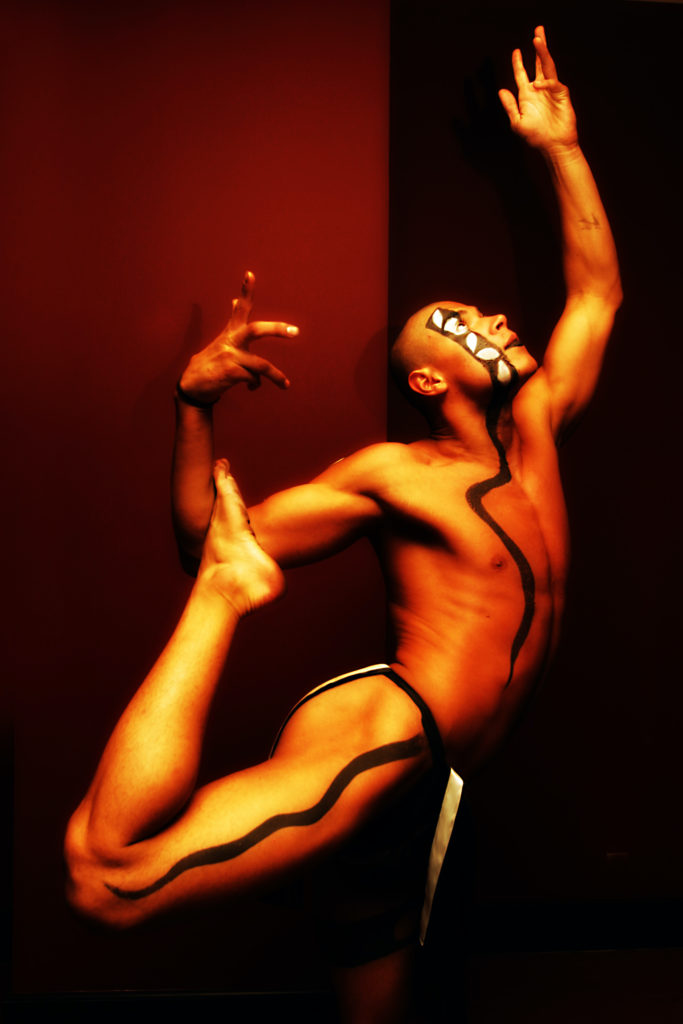
[Image Description: Bald Indigenous male dancer wearing a black and white loincloth with matching makeup trailing from his face down his body and around his lifted right leg. His head and left arm are raised towards the sky. The stage behind him is dark red and black.]
Birthed from a vision from Founding Artistic Director Rulan Tangen to create global Indigenous contemporary performing arts opportunities, Dancing Earth is rooted with one foot in Yelamu – occupied Ohlone territory also known as San Francisco, California and the other foot in Ogaa Po Ogeh – occupied Tewa territory also known as Santa Fe, New Mexico. As they usher in a new year, we reflect on the journey of this dance organization, from grassroots to cyberspace. Through multidisciplinary cultural contemporary arts, Dancing Earth puts the spotlight on ecological and humanitarian messages, stories, and calls to action. Dancing Earth’s evolution of the past 17 years encompasses storytelling, addressing urgency of water protection, showing importance of caring for Mother Earth, global connections, online digital performance innovation, community outreach education and more. Cultivating creativity for over 50 global Indigenous and intercultural artists in these years, the first artists journey began by exploring their ancestral embodiment through innovative forms, which expanded diversity in the performing arts.
Have you ever felt the patterns of streams and rivers running through your veins and considered what ancestral knowledge is infused in your bones?
Dancing Earth explored such concepts, peeling back layers through deep movement improvisations. Creating raw, essential, ancient and futuristic expressions. This introspective approach placed emphasis on collaborating artists’ stories and expressions.
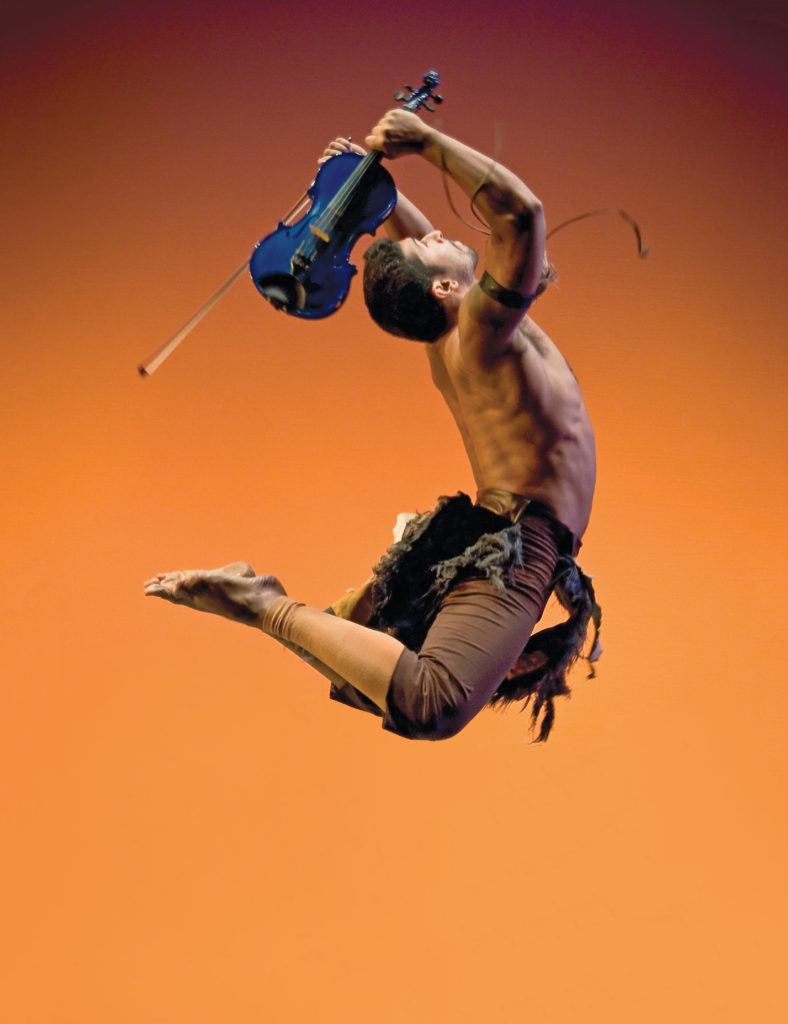
[Image Description: Indigenous male dancer wearing dark brown pants over orange leggings leaping into mid-air with a violin raised above his head as he looks towards the sky. The backdrop is a gradient of orange.]
In 2004 Dancing Earth began their first series of short works at Dance Mission, Thunderstomp which follows a young dancer who traces a constellation pattern on the ground, activating a vision of elemental ancestors: entities of fire, water and whirlwind who surround him with a storm that connects them to the cosmos.
The cast consisted of dancers with training in breakdancing, martial arts, music and visual art. Selecting which dancer played each role was decided through the elements the dancer related to from their own cultural cosmologies. In an interview with Hemispheric Institute cast member Thosh Collins (Onk Akimel O’odham/Wa-Zha-Zhi/Haudenosaunee) shared, “Being involved with Dancing Earth, it’s been able to allow me to incorporate some of my artistic expressions as a dancer and also to incorporate certain morals and values and stories and viewpoints of our people.” Collins speaks to how indigeneity cannot be separated from indigenous peoples; specifically as creatives the art we create is a reflection of who we are. Dancing Earth is a culmination of global indigenous peoples, with varying movement training and backgrounds. For many the organization acts as a creative environment to access hidden skills and knowledge. Dancers find authenticity in the choreography through bringing aspects of themselves into the work. The creative approach placed emphasis on collaborating artists’ stories and expressions. The intention was to bring out the unique qualities, skills and strengths of each artist.
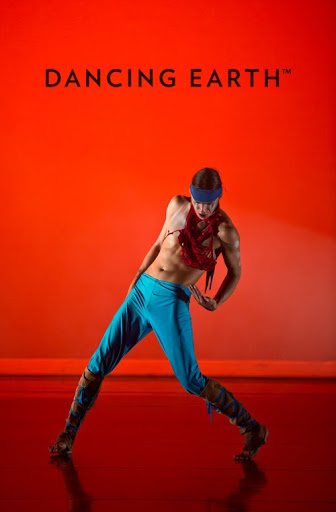
[Image Description: Indigenous male dancer leaning to their left in blue pants and no shirt against a bright red background.]
Dancing Earth performed Thunderstomp at the Red Rhythms Conference at University of California, Riverside on occupied Cahuilla land. Scholars and performers from a variety of traditions and backgrounds gathered at UC Riverside for the conference organized by professors Jacqueline Shea Murphy and Michelle Raheja. This marked one of Dancing Earth’s first major performances and would be the beginning of their journey as a dance company.
The following year the company would perform in Belo Horizonte, Brazil for the 5th Encuentro of the Hemispheric Institute of Performance and Politics, titled Performing Heritage: Contemporary Indigenous and Community-Based Practices. This held significance to the cast Rulan Tangen, Alejandro Meraz (Purepecha), Thosh Collins, Quetzal Guerrero (Juaneño/Acjachemen/Opata/Kambiwa) as artists working in global communities and Brazil being an ancestral home for cast member Quetzal Guerrero. This international opportunity sparked ongoing global relationship building and exchange.
As the company shared their work with more communities, people were inspired by seeing diversity represented in contemporary dance works, which sparked desire in others to be involved. There were requests for more workshops and training opportunities. Indigenous youth were hungry for creative opportunities that embraced diversity and cultural worldviews. In 2012, students Anne Pesata (Jicarilla Apache) and Lupita Salazar (Chicana) suggested longer training sessions, particularly for indigenous and rural youth who might lack the resources to attend weekly classes. This call to action led to the creation of Dancing Earth’s summer intensives, dancing together outdoors. The collective considers the question “What are the stories within our bodies that connect us to land, water, sky and each other” Tangen (Kampampangan/Pangasinan/Norweigian) reveals. These summer intensives are known as spaces of reciprocity, sustainability, skill sharing, exchange, and accessing ancestral knowledge/embodied knowledge and stories we didn’t know we knew. Artists from around the globe and local communities have been coming together for the last 8 summers to reground, build movement vocabulary, and exchange artistic and cultural practices. Making opportunities for the next generations of emerging Indigenous artists has always been a priority for Dancing Earth carried through to present day.
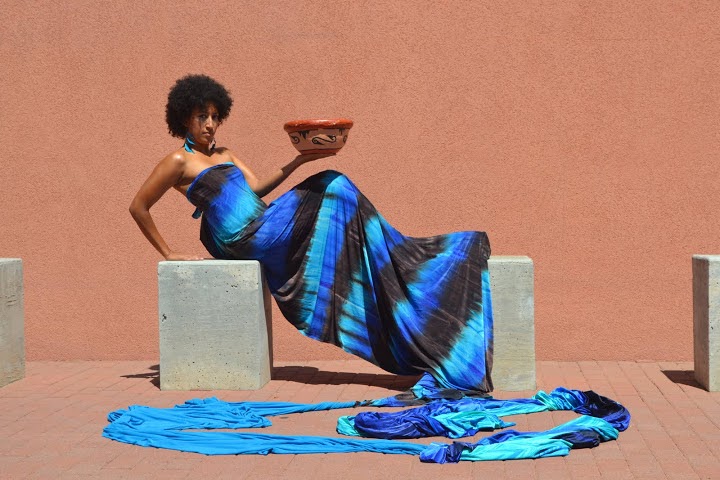
[Image Description: Medium-brown skinned young Black woman with a dark brown curly Afro wearing a light blue, dark blue and black striped maxi dress is seated upon a rock column outdoors while holding a terracotta bowl. Material matching the colors of the dress is draped on the ground in front of her.]
Almost a decade later Tangen was invited by Anishnaabeg/Metis grandmothers to research the Indigenous perspectives on water issues in conjunction with the Indigenous Performance Initiative at Trent University in Canada. This led to the development of Walking at the Edge of Water described by Dancing Earth as a “multi-disciplinary expression of arts dedicated to the healing of water,” created by 17 dance artists and cultural advisors. In 2012 the production premiered at the Lensic Theater in Santa Fe, New Mexico. Continuing Dancing Earth’s grass roots of working with what you have, sustainability and repurposing, this eco-production used costumes and props created from repurposed materials. Walking at the Edge of Water brought awareness to water issues, sharing stories through movement, sound and visual art. Jennifer Foerster, Muscogee poet and audience member, commented on the hope the work installed: “…Truly inspiring about the humanity and potential of all people.”
Dancing Earth worked with multiple communities gathering indigenous perspectives and stories about water. What made this production a pivotal moment in the company’s growth was the shift from introspective artist-driven stories to community members, elders, collaborators and peers being moved to share their stories after experiencing Dancing Earth’s work. The multitude of stories provided a wider scope of perspectives and detailed experiences, ideas and embodiments of their relationship to water, ultimately creating a flow of reciprocity between Dancing Earth and communities.
In the company’s ninth year they shared Walking at the Edge of Water on an international tour to Aotearoa (New Zealand) for the Kowhiti Festival. The experience of sharing, creating, and exchanging between indigenous artists/organizations lead to building and maintaining global friendships. Dancing Earth continued to expand through international tours while balancing engagement in local communities. “Every time we offer a dance it changes depending on where we are and who is with us,” Tangen explains. Adaptability and sustainability are identified as core values of the collective.
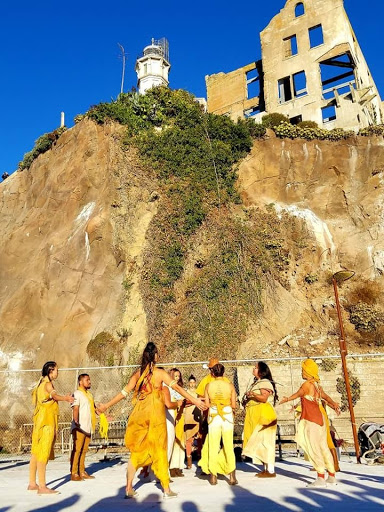
[Image Description: Group of dancers standing in a circle, all wearing varying shades of yellow and tan dresses, shirts, and pants. They are at the bottom of a hillside that is sprawling with lush greens and deep brown ruddy soil and solid rocks.]
Groundworks Alcatraz was a project developed by Dancing Earth in collaboration with California Native communities in 2018, delivering a message of urgency for land acknowledgement in the form of relationship building. Wherever you are right now, take a moment to feel the ground beneath you. Do you know the original name of this land? Or the name of the peoples who are the caretakers of this land? Groundworks Alcatraz centers the untold stories and creative contributions of cultural collaborators of Pomo, Ohlone, Wappo, Tongva, Paiute of California First Peoples. Gatherings took place during winter, spring and summer, culminating in a performance on Alcatraz after the Indigenous People’s Day Ceremony in the fall. Dancing Earth describes the work: “Groundworks disrupts settler-colonizer notions with contemporary performance highlighting forgotten histories.”
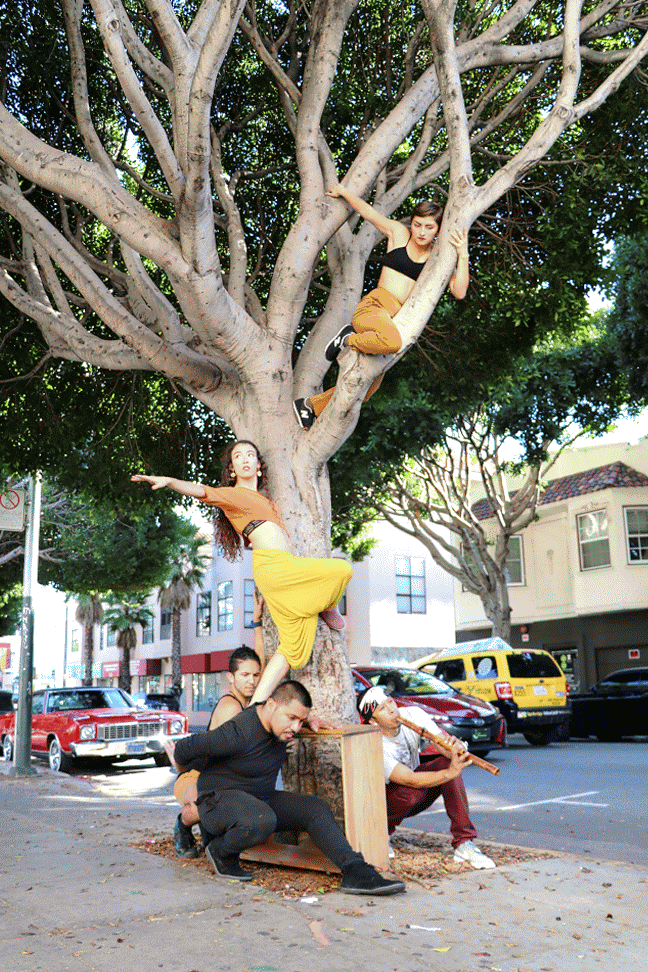
[Image Description: Three male dancers kneel surrounding the base of a tree wearing varying costumes in dark brown, black and white. One woman with long brown hair down her back wearing a mustard yellow dress is climbing the trunk of the tree. Another woman seated on a branch wears a black crop top with orange pants and grasps the tree branches above.]
Tangen explains this work like an oak tree, from which acorns drop, planting new seeds. From Groundworks Alcatraz many side projects bloomed such as Acorn Duet (made with support of Emily Johnson/Catalyst dance), ReIndigenize the Streets a special event centering local Native artists – produced by Tisina Ta-till-ium Parker (Ahwahnee Miwok, Kucadikadi Paiute) co presented by Dance Mission, and Chishkale (a short documentary film produced by Dance Mission). Ian Garrett (ToasterLab) produced media for this work and two years later contributed as a Technical Director and Visual Artist for Dancing Earth’s first online performance.
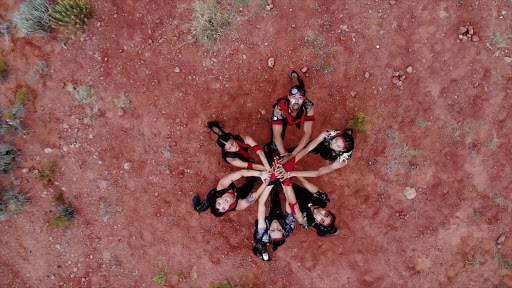
[Image Description: Mixed group of dancers wearing red, white and black costumes and tribal makeup. Standing on pinkish-red ground, they form a circle with their arms extended towards the middle while holding one hand over a clasped fist. The camera captures the group from above with all dancers looking up at the camera.]
Fast-forward to 2020, in true artist resilience despite many challenges there was also groundbreaking innovation, adaptability, and transformation. In June 2020 Dancing Earth, presented by ToasterLab and produced by HowlRound TV, launched into cyberspace with their first online performance IF: Indigenous Futurities, expanding to include digital global creative collaboration and reach a global audience. At a time when artists were feeling the struggle of creating while in isolation, this project came at an essential time to bring global indigenous artists together. “We come together as people from diverse backgrounds to make space of accountability and powerful calls to action,” explains Eugene Trey Pickett (Afro-Indigenous/Cherokee). The organization doesn’t shy away from addressing difficult subjects and activating change.
The cast explored finding the ways we are connected at a time of distancing, re-imagining possibilities of global cultural contemporary performance art in cyberspace and the ancestral knowledge and stories that can teach us about resilience in the remaking of the world. “One can’t assume they know everything, and this type of engagement with members of different communities is what brings us together and keeps us curious about the world we all live in,” says Lumhe Micco Sampson (Seneca/Mvskoke). IF: Indigenous Futurities provided a space for connection, finding the meeting places between cultures, backgrounds, knowledge, understandings and communities. The company website describes the work: “Collaborating artist visionaries reveal cyberspace as a realm of ritual, to reimagine the future from the brink of collapse of the dominant system and re-emergence of cultural cosmologies.”
Dancing Earth continued to evolve by presenting two online summer intensives, connecting Indigenous artists from around the world without the requirement of travel, making the program even more accessible than before. From March to November 2020, Dancing Earth held over 100 online offerings during the Covid-19 pandemic to keep dancers teaching, people moving, and communities connecting.
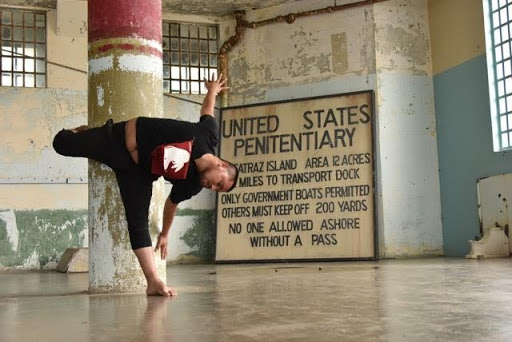
[Image Description: Male dancer is standing on leg, with the other wrapped around the column behind him with his body parallel to the ground and his arms outstretched. He is wearing knee-length black pants and a black short sleeve shirt that shows the silhouette of an Indigenous person.]
The organization closed out the year with BTW US Cyberspace, a six-episode series following a journey of healing and re-discovering ancestral knowledge. This was created by transforming the original theater production of Between Underground & Skyworld into digital performance art mini series. During a time where we see political and social issues reaching a boiling point and brought into acceleration by a pandemic, performance art continues to evolve, raise awareness and offer spaces of expression and release for individuals and collectives to process their experiences, thoughts and feelings.
The field of Indigenous contemporary performance arts has created opportunities and experiences that empower peoples. Youth who have attended workshops or performances by Dancing Earth have continued on to join the company, teach or create their own work. Like all things that grow and evolve there will be challenges, highs and lows, but it is the passion, commitment and resiliency that keeps Dancing Earth in reflection and renewal. Globally Indigenous peoples have demonstrated resilience for centuries, and that can be witnessed in their embodied expression as artists. To say it’s hard work would be an understatement, doing generations of work undoing trauma, building community and healing, so the future generations can dance free.
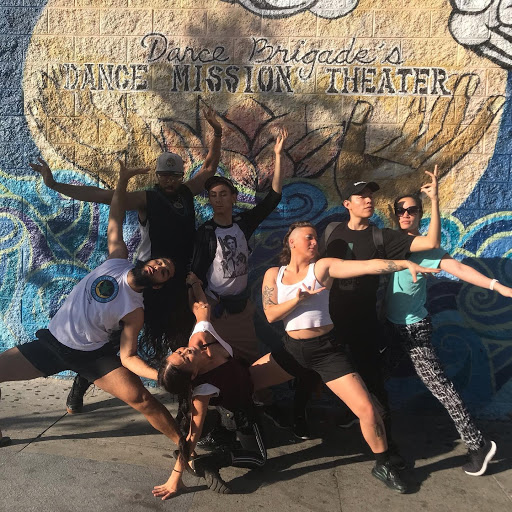
[Image Description: A group of dancers dressed casually in athleisure wear poses with their arms outstretched in front of a mural that says “Dance Brigade’s Dance Mission Theater.”]
As Dancing Earth begins their 18th year, addressing ecological and humanitarian messages, stories and calls to action remain central to their vision. Their journey has been one of innovation and as a new year begins expect to see Dancing Earth continuing to evolve, growing like the oak tree; branches reaching towards the sky, with roots still connected deep within the Earth.
This article appeared in the Winter 2021 issue of In Dance.


